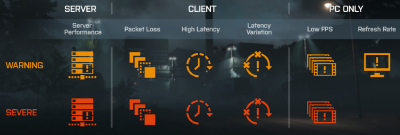I'm sure we've all seen these icons appearing in game from time to time but have you ever wondered they actually mean?
While some of these issues are harder to resolve than others the best thing we you really do to negate their in game effects is to play on local servers where possible and keep your local network and internet connection free where you can. This will help ensure you have the best connection to the game servers and give you a rubber band free, lag-less game experience.
Hopefully this info sheds some light on those pesky connection issues and may help point you in the right direction to find a fix for them.
 SERVER
Server performance
SERVER
Server performance
Indicates server side issues. Can result in lag on the local client or other server connection issues and will usually result in a server crash or reboot. In most cases the server will crash before this warning is displayed but is generally rare for console servers anyway
CLIENT
Packet loss
Packet loss occurs when one or more packets of data travelling across a computer network fail to reach their destination. Packet loss is typically caused by network congestion. Packet loss is measured as a percentage of packets lost with respect to packets sent.
When people try to think of how “good” their internet connection is, they usually use three major factors as their benchmarks: Download Speed, Upload Speed, and Ping*. These of course are used for very good reason and are a decent marker of how strong your connection is. Yet, it is still often possible to have network issues and have these three settings (especially your Ping), all be within acceptable ranges and this can be problematic.
One of the biggest sources of this type of problem is something called “packet loss.” You can still have a very good ping but be having issues with packet loss because although the data is being sent and ultimately received fairly quickly by the destination server, not all of the data is getting there correctly. One of the biggest tell-tale signs of packet loss would be in a multiplayer round of conquest all the sudden you local client stars lagging or rubber banding and then possibly finally dropped out completely. However, even though battlefield was having issues, you might still be able to talk to your friends over xBox Live Chat. The reason that only one specific program in that case had problems is because of how its data was transmitted over the internet and what route it was taking.
High latency
Network latency is an expression of how much time it takes for a packet of data to get from one designated point to another. In some environments, latency is measured by sending a packet that is returned to the sender; the round-trip time is considered the latency.
Every time you play online multiplayer Battlefield game modes it takes your xBox a certain amount of time to contact the host and begin the data retrieval process. Your console may be performing dozens or hundreds of these connections per second—juggling incoming versus outgoing traffic, and, in some cases, prioritizing content that needs to be delivered immediately. How long it takes to initiate these connections, and how quickly the data arrives, is critical to the Internet connection’s perceived speed.
If you’re playing an online game, latency may be far more important than bandwidth.
Latency variation
In computer networking, packet delay variation (PDV) is the difference in end-to-end one-way delay between selected packets in a flow with any lost packets being ignored. The effect is sometimes referred to as jitter.
The latency variation referred to is the variation on the UDP packet round trip and includes the server and client additional latency.
The delay is specified from the start of the packet being transmitted at the source to the start of the packet being received at the destination. A component of the delay which does not vary from packet to packet can be ignored, hence if the packet sizes are the same and packets always take the same time to be processed at the destination then the packet arrival time at the destination could be used instead of the time the end of the packet is received.
In addition to high latency, latency variation will also increase lag and rubber banding on the local client as online games need steady a latency to perform smoothly as the server constantly needs to adjust to your latency speed. The less variation, the more stable the game play.
* Ping
Ping on its own is a measure of how long it takes a sent packet of data to go from your computer or device to a receiving node somewhere in cyberspace. Generally, ping is lower when it comes to nearby server locations, but this isn’t always true due to issues in the network pipeline. Even with your ping being very high, it is quite possible to have issues with the constant flow of data, which may not itself be noticeable in general web-browsing but will certainly be a problem when it comes to dynamic data use.
When playing online game modes in Battlefield use the server browser to help select servers with strong ping connections which will be in your local region. This will ensure you have the best possible host location to give you the most stable connection available.
| Description: |
| Battlefield 4 packet loss and latency icons explained |
|
| Filesize: |
281.11 KB |
| Viewed: |
4789 Time(s) |

|